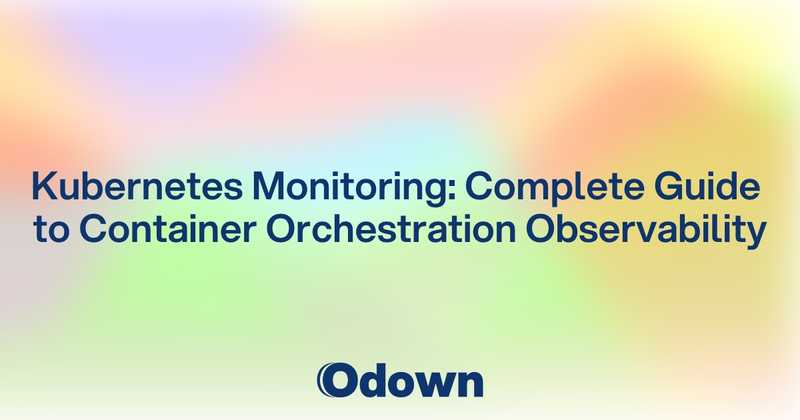Kubernetes Monitoring: Complete Guide to Container Orchestration Observability
Your Kubernetes cluster looks healthy from the outside. All nodes are ready, deployments show green checkmarks, and kubectl commands respond normally. But users are experiencing random timeouts, some services are mysteriously slow, and your pods keep getting killed for reasons you can't figure out.
This is the reality of Kubernetes monitoring. Traditional infrastructure monitoring that worked fine for virtual machines completely misses the dynamic, layered complexity of container orchestration. Pods get created and destroyed constantly. Services span multiple nodes and availability zones. Resource limits, networking policies, and scheduling decisions all affect performance in ways that aren't obvious from basic health checks.
Kubernetes monitoring requires understanding performance at multiple layers simultaneously: cluster infrastructure, node resources, pod lifecycles, container performance, and application behavior. Each layer provides different insights, and problems at any layer can cascade through the entire system in unpredictable ways.
Essential Kubernetes Metrics: Pods, Nodes, and Cluster Health
Effective Kubernetes monitoring starts with understanding the key metrics that indicate cluster health and performance at each architectural layer.
Cluster-Level Health Indicators
Cluster health begins with the Kubernetes control plane components that manage the entire system. API server responsiveness affects every operation in your cluster, from deployments to scaling decisions to monitoring itself.
Monitor etcd performance closely since it stores all cluster state. Slow etcd operations cause everything else to slow down, including pod scheduling, service discovery, and configuration updates. etcd latency and throughput metrics often predict cluster performance problems before they become user-visible.
Controller manager metrics reveal how well Kubernetes can maintain desired state. High controller lag indicates that the system is struggling to keep up with changes, which can lead to delayed pod restarts, slow scaling operations, and inconsistent service behavior.
Scheduler metrics show how efficiently Kubernetes places new pods on available nodes. Poor scheduler performance leads to uneven resource distribution, failed pod placements, and suboptimal application performance.
Node resource availability across the cluster indicates capacity constraints that might affect future pod scheduling. Tracking available CPU, memory, and storage across all nodes helps predict when cluster expansion becomes necessary.
Node Performance Monitoring
Individual node health affects all pods running on that node, making node-level monitoring critical for understanding application performance patterns.
CPU usage patterns reveal both current performance and capacity planning needs. High CPU utilization might indicate that nodes are properly utilized, or it might suggest that workloads need better resource allocation or additional cluster capacity.
Memory usage requires careful attention because Kubernetes will kill pods that exceed memory limits. Monitor both actual memory consumption and memory pressure conditions that might trigger pod eviction before limits are reached.
Network performance between nodes affects inter-pod communication and service discovery. Network latency, packet loss, and bandwidth utilization all impact distributed application performance in ways that might not be obvious from application-level monitoring.
Storage performance and availability affect persistent workloads and stateful applications. Monitor both node-local storage and network-attached storage performance to identify bottlenecks that could affect application performance.
Node conditions like disk pressure, memory pressure, and network unavailability provide early warning of problems that might affect pod scheduling and performance.
Pod Lifecycle and Health Monitoring
Pods represent the fundamental unit of deployment in Kubernetes, and their lifecycle patterns reveal important insights about application health and cluster behavior.
Pod restart patterns often indicate underlying problems even when applications appear to be running normally. Frequent restarts might suggest resource constraints, application bugs, or infrastructure problems that need attention.
Pod scheduling latency shows how quickly Kubernetes can place new pods on available nodes. Long scheduling delays might indicate resource constraints, complex scheduling requirements, or cluster performance problems.
Container state transitions reveal application startup behavior, crash patterns, and resource allocation issues. Monitor container creation time, startup duration, and termination reasons to understand application performance characteristics.
Resource usage against limits and requests helps identify whether resource allocations match actual application needs. Pods that consistently approach their limits might need additional resources, while pods that use far less than requested waste cluster capacity.
Readiness and liveness probe success rates indicate application health from Kubernetes' perspective. Probe failures often precede user-visible performance problems and provide early warning of application issues.
Container-Level Monitoring: Resource Usage and Performance Tracking
Container monitoring provides visibility into individual application instances while accounting for the shared resource environment that containers create.
Resource Consumption Patterns
Memory usage monitoring must account for different types of memory consumption including working set, cache usage, and swap activity. Containers often use memory differently than traditional applications because of shared kernel resources and container runtime overhead.
CPU usage patterns in containers reflect both application demand and CPU throttling imposed by Kubernetes resource limits. CPU throttling can cause performance problems even when overall node CPU utilization appears normal.
Network I/O monitoring reveals communication patterns between containers and external services. High network usage might indicate inefficient service communication, chatty applications, or insufficient caching.
Filesystem I/O patterns show how containers use storage resources and can reveal performance bottlenecks in persistent volume access or temporary storage usage.
Container startup time affects application availability and scaling responsiveness. Monitor container initialization duration, image pull time, and application startup latency to identify optimization opportunities.
Multi-Container Pod Dynamics
Sidecar container monitoring reveals how supporting containers affect main application performance. Service mesh proxies, logging agents, and monitoring sidecars all consume resources that affect overall pod performance.
Shared resource usage between containers in the same pod requires coordinated monitoring to understand total resource consumption and identify resource contention issues.
Inter-container communication patterns within pods show how tightly coupled applications interact and whether container boundaries are optimal for performance and maintainability.
Container dependency relationships affect startup ordering, readiness determination, and failure propagation within pods. Monitor these relationships to understand how container failures affect overall application availability.
Container Image and Registry Performance
Image pull performance affects pod startup time and scaling responsiveness. Large images, slow registry connections, or missing image layers can significantly delay container startup.
Image layer caching effectiveness reveals whether container deployments are optimized for your cluster configuration. Poor caching leads to unnecessary network traffic and slower deployments.
Registry availability and performance affect all container operations including deployments, scaling, and node additions. Monitor registry response times and availability to identify infrastructure bottlenecks.
Security scanning and compliance monitoring for container images should integrate with performance monitoring to ensure that security measures don't create unnecessary performance overhead.
Kubernetes Logging and Distributed Tracing Strategies
Container orchestration creates complex logging and tracing challenges because applications span multiple containers, pods, and nodes that change dynamically.
Centralized Logging Architecture
Kubernetes logging requires centralized collection strategies that work reliably despite ephemeral container lifecycles. Containers and pods disappear frequently, taking their local logs with them unless logging is externalized.
Log aggregation patterns must handle high-volume log streams from many containers while providing efficient search and analysis capabilities. Popular approaches include ELK Stack (Elasticsearch, Logstash, Kibana), EFK Stack (Elasticsearch, Fluentd, Kibana), and cloud-native logging services.
Log correlation across containers and pods requires consistent formatting and metadata inclusion that enables meaningful analysis of distributed application behavior. Include pod names, namespaces, node information, and request tracing identifiers in all log entries.
Log retention and storage management become critical at scale because Kubernetes environments generate enormous log volumes. Implement log lifecycle policies that balance analysis needs with storage costs and compliance requirements.
Structured logging practices enable more sophisticated analysis and alerting than traditional text-based logs. Use JSON or other structured formats that support efficient parsing and querying.
Distributed Tracing Implementation
Kubernetes applications often implement microservices architectures that require distributed tracing to understand request flows and performance bottlenecks across multiple services.
Service mesh integration provides automatic distributed tracing for service-to-service communication without requiring application code changes. Popular service meshes like Istio, Linkerd, and Consul Connect include distributed tracing capabilities.
Application-level tracing instrumentation captures business logic performance and custom application metrics that infrastructure tracing might miss. Use OpenTracing or OpenTelemetry standards for vendor-neutral tracing implementation.
Trace sampling strategies balance comprehensive visibility with performance overhead and storage costs. Intelligent sampling can provide detailed traces for interesting requests while reducing overhead for routine operations.
Cross-cluster tracing becomes important in multi-cluster Kubernetes deployments where requests might span multiple clusters or cloud providers.
Log and Trace Correlation
Correlate logs and traces using common identifiers that flow through distributed request processing. This correlation enables comprehensive root cause analysis that combines detailed application logs with performance timing data.
Error correlation between logs and traces helps identify the relationship between application errors and performance problems. Slow performance often precedes or follows error conditions in predictable patterns.
Business context correlation connects technical logs and traces to business operations and user workflows. This context helps prioritize investigation efforts based on business impact rather than just technical severity.
Alert integration with logs and traces provides rich context for incident response. Instead of just knowing that something is wrong, responders get detailed information about what was happening when problems occurred.
Kubernetes Security Monitoring: Threats and Detection Mechanisms
Kubernetes security monitoring must address unique attack vectors and threat patterns that don't exist in traditional infrastructure environments.
Runtime Security Monitoring
Container runtime monitoring detects malicious activity inside running containers including unauthorized process execution, network connections, and file system modifications.
Behavioral analysis compares actual container behavior against expected patterns to identify anomalous activity that might indicate compromise. Containers should have predictable behavior patterns that make anomalies easier to detect.
Syscall monitoring provides detailed visibility into container operations and can detect sophisticated attacks that might not be obvious from higher-level monitoring.
Network traffic analysis between pods and to external services reveals communication patterns that might indicate data exfiltration, command and control communications, or lateral movement.
Kubernetes API Security
API server access monitoring tracks all operations performed through the Kubernetes API including pod creation, configuration changes, and resource access. Unusual API usage patterns often indicate security problems.
RBAC (Role-Based Access Control) monitoring ensures that access policies are working correctly and identifies potential privilege escalation attempts or overly permissive access grants.
Service account monitoring tracks automated system access and helps identify compromised service accounts that attackers might use for persistent access.
Admission controller monitoring reveals whether security policies are being enforced correctly and identifies attempts to bypass security controls.
Configuration and Compliance Monitoring
Security policy compliance monitoring ensures that pods and configurations meet security standards and identifies deviations that might create vulnerabilities.
Secret management monitoring tracks how sensitive information is stored, accessed, and used within the cluster. Poor secret management practices often create security vulnerabilities.
Network policy enforcement monitoring ensures that network segmentation policies are working correctly and identifies unauthorized communication between services or namespaces.
Resource quotas and limits monitoring prevents resource exhaustion attacks and ensures that security policies include appropriate resource controls.
Threat Detection and Response
Automated threat detection correlates security events across multiple data sources to identify attack patterns that might not be obvious from individual security events.
Incident response automation can automatically isolate compromised pods, preserve forensic evidence, and maintain service availability during security incidents.
Vulnerability scanning integration monitors container images and cluster configurations for known security vulnerabilities and provides remediation guidance.
Compliance reporting provides evidence that security monitoring and controls are working correctly for audit and regulatory requirements.
Multi-Tenant Security Monitoring
Namespace isolation monitoring ensures that tenant separation is working correctly and identifies potential tenant-to-tenant security issues.
Resource sharing monitoring tracks how shared cluster resources are used and identifies potential security implications of resource contention or isolation failures.
Cross-tenant communication monitoring identifies unauthorized communication between different tenants or applications that might indicate security problems.
Kubernetes monitoring transforms container orchestration from an opaque black box into a transparent, observable system where you understand exactly what's happening at every layer. This visibility enables proactive problem resolution, efficient resource utilization, and robust security posture.
The investment in comprehensive Kubernetes monitoring pays dividends in improved application reliability, faster incident resolution, and better resource efficiency. You finally get the visibility needed to run complex containerized applications with confidence.
Ready to implement comprehensive Kubernetes monitoring? Odown provides container-aware monitoring that tracks pod health, cluster performance, and application availability across your entire Kubernetes infrastructure. Combined with our cloud infrastructure monitoring strategies, you'll have complete visibility into both your orchestration platform and the cloud infrastructure that supports it.



